 We continued our journey north through the dramatic wildernesses of Argentina’s northwest. The journey to the this corner of Argentina turned out to be an amazing road trip, with each day revealing new landscapes, sometimes several a day. This blog is presented as a photo story, to try to relay some of the drama of what we saw.
We continued our journey north through the dramatic wildernesses of Argentina’s northwest. The journey to the this corner of Argentina turned out to be an amazing road trip, with each day revealing new landscapes, sometimes several a day. This blog is presented as a photo story, to try to relay some of the drama of what we saw.
On 16th June, we started travelling north again, by-passing the city of Mendoza by taking a beautiful, and what seemed to us at that stage, a high level pass along the edge of the Andes. We weaved north, on and off the famous Ruta 40 that follows the Andes the full length of this huge country, sometimes choosing spectacular less driven roads. After a night in a delightful little campsite tucked in a dramatic gorge on the little RP49, kept company by a trio of small matching dogs and with condors still to be seen soaring in the sky above us…
After a night in a delightful little campsite tucked in a dramatic gorge on the little RP49, kept company by a trio of small matching dogs and with condors still to be seen soaring in the sky above us…
We emerged next morning on the other side of the hills to this dramatic landscape – the first of many on this stage of our journey 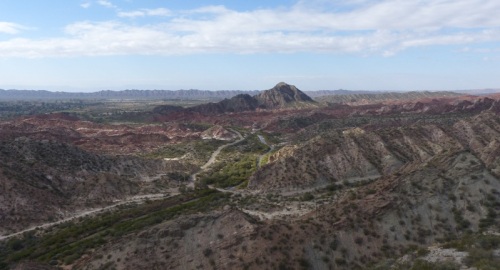
The Valley of the Moon, P.N. Ischigualasto
This was the edge of the region that contains Argentina’s “Valle de la Luna” (Valley of the Moon) in the Parque Nacional Ischigualasto, which would be our next stop.  Entrance into the park is by a daily tour in a convoy, with the guide travelling in the first car.
Entrance into the park is by a daily tour in a convoy, with the guide travelling in the first car.  The day we went in turned out to be rather overcast, adding to the drama of the place.
The day we went in turned out to be rather overcast, adding to the drama of the place. 
 Apparently nobody has an explanation for how these balls of stone were formed, but it is likely to have been some form of volcanic process.
Apparently nobody has an explanation for how these balls of stone were formed, but it is likely to have been some form of volcanic process. 
 The park is most famous for its dramatic rock formations, given names such as the “submarine” and the “mushroom”, which are expected to fall down in the next 50 years!
The park is most famous for its dramatic rock formations, given names such as the “submarine” and the “mushroom”, which are expected to fall down in the next 50 years! 
 But for us, it was the colours of the rock, with different coloured layers, from different geologic eras, being visible one on top of the other, that we found most exciting. We continued to see these layers as we travelled north.
But for us, it was the colours of the rock, with different coloured layers, from different geologic eras, being visible one on top of the other, that we found most exciting. We continued to see these layers as we travelled north. 
The Incan ruins at Shincal
Our next stop, a couple of day’s driving later, was our first Inca site, the ruins of Shincal, the most southern Inca city on a major crossroads of the Incan road system. It is a beautiful site, tucked, well protected, in a curve of hills, with the Andes behind.  The valley that contained the town had both a hill of the sun (on the east side) and a hill of the moon (to the west), each with a stairway to the sky climbing up the western side, with the major buildings sitting between them.
The valley that contained the town had both a hill of the sun (on the east side) and a hill of the moon (to the west), each with a stairway to the sky climbing up the western side, with the major buildings sitting between them. 


 It would have been populated by around 800 people, who were conquered and cleared from the area by the Spanish conquistadors in the 16th Century. Interest in the pre-Columbian peoples and their history is being revived. Nevertheless, we were rather surprised to find, this far south where no populations of indigenous people were allowed to remain, that the Incan mid-winter festival of Inti Raymi was going to be celebrated at the ruins that night (20th June). We had already spent the night parked quite comfortably at the gates of the site and, having been invited to join and welcomed by the Guarani man who had come to preside over the ceremony, we decided to stay. We started the proceedings by climbing up the hill of the sun at sunset to see the last of the sun light disappear at the end of the shortest day.
It would have been populated by around 800 people, who were conquered and cleared from the area by the Spanish conquistadors in the 16th Century. Interest in the pre-Columbian peoples and their history is being revived. Nevertheless, we were rather surprised to find, this far south where no populations of indigenous people were allowed to remain, that the Incan mid-winter festival of Inti Raymi was going to be celebrated at the ruins that night (20th June). We had already spent the night parked quite comfortably at the gates of the site and, having been invited to join and welcomed by the Guarani man who had come to preside over the ceremony, we decided to stay. We started the proceedings by climbing up the hill of the sun at sunset to see the last of the sun light disappear at the end of the shortest day.  Later, wrapped up warm, we watched a ceremony around a fire to make offerings to Pachamama, the earth/time mother goddess of the Incas.
Later, wrapped up warm, we watched a ceremony around a fire to make offerings to Pachamama, the earth/time mother goddess of the Incas.  After the ceremony, we joined the small group, mostly, it appeared, of modern Argentinians with an interest in the old religions, with perhaps one or two people of indigenous descent only, as they started their all night, long, cold, mid-winter night, vigil around the fire.
After the ceremony, we joined the small group, mostly, it appeared, of modern Argentinians with an interest in the old religions, with perhaps one or two people of indigenous descent only, as they started their all night, long, cold, mid-winter night, vigil around the fire. We had visions of a lively party, perhaps dancing, but it was in fact a rather sombre affair, with gentle hymn-like singing, to the accompaniment of drums and pipes. We retired later in the evening… Next morning, we got up while it was still dark to go and ensure we saw the sunrise after the longest night. We climbed the hill of the moon (figuring we would be out of the way, but could watch proceedings without getting drawn in) and waited, trying to keep warm, for the first rays of sun. We were a little early… Daylight comes some time before the sun actually makes its appearance above the hills to the east.
We had visions of a lively party, perhaps dancing, but it was in fact a rather sombre affair, with gentle hymn-like singing, to the accompaniment of drums and pipes. We retired later in the evening… Next morning, we got up while it was still dark to go and ensure we saw the sunrise after the longest night. We climbed the hill of the moon (figuring we would be out of the way, but could watch proceedings without getting drawn in) and waited, trying to keep warm, for the first rays of sun. We were a little early… Daylight comes some time before the sun actually makes its appearance above the hills to the east.  Just before the sun did appear, at about 9am, the group made it’s way up the staircase to the sky to the top of the hill of the sun to wait and visibly celebrated when the sun’s rays finally reached them. And fair enough to, it must have been a long, cold night! We were rather pleased to feel the warmth of the sun after just an hour plus of waiting!
Just before the sun did appear, at about 9am, the group made it’s way up the staircase to the sky to the top of the hill of the sun to wait and visibly celebrated when the sun’s rays finally reached them. And fair enough to, it must have been a long, cold night! We were rather pleased to feel the warmth of the sun after just an hour plus of waiting! 

 After a welcome hearty breakfast, we moved on, continuing our journey north, still catching the occasional glimpse of a glacier in the mountains to our side.
After a welcome hearty breakfast, we moved on, continuing our journey north, still catching the occasional glimpse of a glacier in the mountains to our side.  Enjoying the dramatic colours and landscapes,
Enjoying the dramatic colours and landscapes, 

And the odd opportunity to cook outside. 
The Incan ruins of Quilmes
Continuing on the Incan theme, a little further north we stopped at the more well known remains of the Incan town of Quilmes. In contrast to Shincal, this was built up a dramatic hillside, with complex water storage systems, but again protected by flanks of hillside.  Quilmes is famous for holding out against the Spanish conquistadores until finally overcome by a siege. In order to clear the land, the Spanish conquerors marched the 2,000 people remaining in the town when conquered all the way to Buenos Aires, of whom, 500 people survived the journey. They were settled in a region of the Buenos Aires province, where the Quilmes name lives on and has gone on to be where the country’s favourite beer, also called Quilmes, is produced.
Quilmes is famous for holding out against the Spanish conquistadores until finally overcome by a siege. In order to clear the land, the Spanish conquerors marched the 2,000 people remaining in the town when conquered all the way to Buenos Aires, of whom, 500 people survived the journey. They were settled in a region of the Buenos Aires province, where the Quilmes name lives on and has gone on to be where the country’s favourite beer, also called Quilmes, is produced. 


The wine region of Cafayate
 We had been climbing steadily higher and into refreshing climates, with clear, bright, sunny days almost every day of the year, with temperatures dropping dramatically when the sun disappears in the evening. The wine producers south of Salta claim this is perfect wine producing conditions, with the temperature variations and dry climate stressing the vines into producing lovely grapes, and the producer being able to completely control watering of the vines through irrigation. Naturally, we were happy to taste what the highest vineyards in the world produced! The region is most famous for the white Torrontes wine, a dry grape that is difficult to grow elsewhere.
We had been climbing steadily higher and into refreshing climates, with clear, bright, sunny days almost every day of the year, with temperatures dropping dramatically when the sun disappears in the evening. The wine producers south of Salta claim this is perfect wine producing conditions, with the temperature variations and dry climate stressing the vines into producing lovely grapes, and the producer being able to completely control watering of the vines through irrigation. Naturally, we were happy to taste what the highest vineyards in the world produced! The region is most famous for the white Torrontes wine, a dry grape that is difficult to grow elsewhere.
Our few days in Cafayate were a welcome interlude. Unlike Mendoza, this little town is set up for wine tourism, with an interesting museum about wine-making, several bodegas open for visits within walking distance in and around the town, and a lovely little wine bar designed around tasting the local products. This was topped off by a nice little campsite just a short walk from the centre of town – ideal! 
 Cafayate was where we started to experience some local music culture, with many of the restaurants having local “folkloric” singers entertain the patrons over dinner. This was also our first experience of diners getting up to dance, a lovely teasing dance that we were to see regularly during our remaining time in northern Argentina. Here, a couple from Cordoba show us how it is done…
Cafayate was where we started to experience some local music culture, with many of the restaurants having local “folkloric” singers entertain the patrons over dinner. This was also our first experience of diners getting up to dance, a lovely teasing dance that we were to see regularly during our remaining time in northern Argentina. Here, a couple from Cordoba show us how it is done… 
The Ruta 40 and over the pass to Salta
We chose to take the scenic route north to Salta, following a less driven and very picturesque section of the Ruta 40. 



 Such a quiet road made it relatively easy to find campsites – just somewhere flat to pull off the road a bit.
Such a quiet road made it relatively easy to find campsites – just somewhere flat to pull off the road a bit.  Our best sites may have lost the sun early in the evening, but benefitted from it first thing in the morning to help warm us up!
Our best sites may have lost the sun early in the evening, but benefitted from it first thing in the morning to help warm us up!  Stopping for a lunch break in the pretty town of Cachi.
Stopping for a lunch break in the pretty town of Cachi. 

 Up here, we found one of the highest vineyards of the region, therefore the world, at 2,600m or thereabouts – and found a small hotel where we could taste the results, which were surprisingly sweet, probably for local taste.
Up here, we found one of the highest vineyards of the region, therefore the world, at 2,600m or thereabouts – and found a small hotel where we could taste the results, which were surprisingly sweet, probably for local taste. 
 The last stage of the drive to Salta took us over a colourful high pass (about 3,400m),
The last stage of the drive to Salta took us over a colourful high pass (about 3,400m),  and along the edge of the Parque Nacional de Cardones (cacti). We had seen, and would see, this striking tall cacti frequently when at high altitudes, but not in such densities.
and along the edge of the Parque Nacional de Cardones (cacti). We had seen, and would see, this striking tall cacti frequently when at high altitudes, but not in such densities.  They grow a few cm a year, so you can work out how old they are!
They grow a few cm a year, so you can work out how old they are!  Around the corner, on the plain, were our first of many more wild donkeys and some old friends, guanacos.
Around the corner, on the plain, were our first of many more wild donkeys and some old friends, guanacos. 


The rest of the drive was a dramatic descent into the valley on the other side, to rejoin the main road to the city of Salta. 

The Cloud Forest of Parque Nacional Calilegua
 We by-passed Salta to start with, opting to explore some of the regions around it before coming back through the city on route across to Chile a little while later. We started by visiting the Parque Nacional Calilegua, within Argentina’s bit of cloud forest, which, after such a long time in the high, dry deserts, was quite a refreshing change.
We by-passed Salta to start with, opting to explore some of the regions around it before coming back through the city on route across to Chile a little while later. We started by visiting the Parque Nacional Calilegua, within Argentina’s bit of cloud forest, which, after such a long time in the high, dry deserts, was quite a refreshing change. 

 We were lured by promises of many hundreds of bird species and some interesting animals, but, although the forest was dense and rich, we were probably there at the wrong time of year to see it at it’s best, but we did see some new birds, like these colourful, but rather cheeky, jays,
We were lured by promises of many hundreds of bird species and some interesting animals, but, although the forest was dense and rich, we were probably there at the wrong time of year to see it at it’s best, but we did see some new birds, like these colourful, but rather cheeky, jays, 

As well as some pretty critters…  Neither of us had seen a translucent butterfly before:
Neither of us had seen a translucent butterfly before:  Some of the multitude of critters went on to attack us! Little flies that we think must have been a type of black fly left us with several itchy bites each before we realised what was happening.
Some of the multitude of critters went on to attack us! Little flies that we think must have been a type of black fly left us with several itchy bites each before we realised what was happening.
Before leaving, we drove all the way up through the park, on a rather narrow, mud road (we were glad it was dry and there wasn’t much traffic!), watching the forest change as we went up through different height levels.





 We emerged in the Guarani village of San Francisco, where we stopped for lunch before turning round to head back down.
We emerged in the Guarani village of San Francisco, where we stopped for lunch before turning round to head back down.  A local gaucho relaxes with a beer, before climbing up past the statue of Pachamama to head home.
A local gaucho relaxes with a beer, before climbing up past the statue of Pachamama to head home.
Clearly somebody doesn’t agree with the statement that this land was “donated” by local people to form the national park. 
Jujuy and the Quebrada de Humahuaca 
Having left the park, we stopped off to see the historic city of Jujuy, Argentina’s northernmost city, where we found a protest on-going related to the recognition of indigenous people in the region. As we had learnt, the Spanish in Argentina had cleared local people form usable land when they conquered the region, but the Guarani living in the forests were ignored and we were now near the Bolivian border, where original indigenous peoples are a significant proportion of the population. Many of the people in this part of Argentina are criollo and we first really saw this cultural difference here in Jujuy. The area has its own distinct music and food culture. 
 We took advantage of a comfortable, sunny campsite nearby to spend a day not moving and catching up on some chores. Here we’ve got all the bedding out for some airing and UV treatment!
We took advantage of a comfortable, sunny campsite nearby to spend a day not moving and catching up on some chores. Here we’ve got all the bedding out for some airing and UV treatment!  We drove north up the Quebrada (gorge or valley) of Humahuaca, famous for it multicoloured sides and hills, stopping in the village of Purnamarca.
We drove north up the Quebrada (gorge or valley) of Humahuaca, famous for it multicoloured sides and hills, stopping in the village of Purnamarca. 

From where we could explore the Cerro de los Siete Colores (Hill of Seven Colours). 
 We went as far north as the town of Tilcara, probably the oldest continuously settled place in Argentina. Traces of human settlement can be found going back 10,000 years. The modern town is set in beautiful valley floor, with partially reconstructed ruins of a pre-Incan pilcara (Quechua for fortress) on a small, well-placed, hill-top next to it.
We went as far north as the town of Tilcara, probably the oldest continuously settled place in Argentina. Traces of human settlement can be found going back 10,000 years. The modern town is set in beautiful valley floor, with partially reconstructed ruins of a pre-Incan pilcara (Quechua for fortress) on a small, well-placed, hill-top next to it. 
 The peoples of the pilcara buried their dead in these small, round chambers.
The peoples of the pilcara buried their dead in these small, round chambers.  People have probably reared llamas in this area for many thousands of years.
People have probably reared llamas in this area for many thousands of years.  Unfortunately, someone decided to build a huge memorial to the archeologists that worked on the site, placing it on top of some of the ruins, in the style of a pyramid the like of which doesn’t even exist in South America! We were left wondering what those archeologists would have thought.
Unfortunately, someone decided to build a huge memorial to the archeologists that worked on the site, placing it on top of some of the ruins, in the style of a pyramid the like of which doesn’t even exist in South America! We were left wondering what those archeologists would have thought.  The lovely little museum in Tilcara had a good little collection of pre-Columbian, plus a moving local memorial to people affected by the disappearances during the military dictatorship – a picture and description of each person.
The lovely little museum in Tilcara had a good little collection of pre-Columbian, plus a moving local memorial to people affected by the disappearances during the military dictatorship – a picture and description of each person.  On the drive back down to Salta, taking the Ruta 9 over the hills between Jujuy and Salta, on what was probably usually a very picturesque drive, if it wasn’t unusually covered in cloud, we saw the aftermath of a minor accident. There’s not much room for mistakes on some of these roads – luckily no one was hurt in this one, but it is reminder not too drive quickly, especially when wet!
On the drive back down to Salta, taking the Ruta 9 over the hills between Jujuy and Salta, on what was probably usually a very picturesque drive, if it wasn’t unusually covered in cloud, we saw the aftermath of a minor accident. There’s not much room for mistakes on some of these roads – luckily no one was hurt in this one, but it is reminder not too drive quickly, especially when wet! 
Salta – music and gauchos
We arrived in Salta on Saturday 4th July, the afternoon of the Copa America final – a big one with Argentina up against Chile. Our first stop was to join a guy we had met at the campsite near Jujuy watching it with some of his friends and, of course, a parilla (Argentinian BBQ). Argentina lost on penalties and, after the match, we went off to tuck the van away in a secure garage and find our little hotel, just in time to turn around and catch Salta on a Saturday night. The city has a number of peñas – places playing local music – and we caught the show at The Old Station. We were now in the land of gauchos and the music was all groups of male singers, with guitars, sometimes drums, pipes etc, singing in close harmony. We were captivated until well into the early hours. 
 The following day, when we finally stumbled out after our late night, we found the streets near the hotel full of gauchos! Apparently it was the “day of the virgin of the gauchos” and there was a religious service being conducted in the nearby plaza, followed by a parade through the streets of gauchos in their Sunday finest.
The following day, when we finally stumbled out after our late night, we found the streets near the hotel full of gauchos! Apparently it was the “day of the virgin of the gauchos” and there was a religious service being conducted in the nearby plaza, followed by a parade through the streets of gauchos in their Sunday finest. 
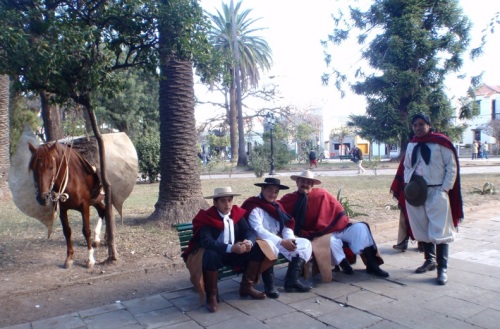 Women out in accompaniment, as well as some of the gauchos, carried their pictures of the virgin.
Women out in accompaniment, as well as some of the gauchos, carried their pictures of the virgin.
 A couple of days later, we pulled into a campsite in the little town of Campo Quijano, about 3okm from Salta, on the route of El Tren de las Nubes (the train to the clouds). We were expecting just to stay the night before continuing on towards the Paso de Sico over the Andes the next morning. However, as we checked in, the campsite manager told us that a festival would be starting the next day, with “muchos gauchos”! So next morning, we went to find out more. It turned out that the festivities for Argentina’s Independence Day would begin that evening, with music in the sports hall next to the campsite, then, the following day, on July 9, also the anniversary of the town’s founding, there was to be a parade and a music festival. We decided to stay for it.
A couple of days later, we pulled into a campsite in the little town of Campo Quijano, about 3okm from Salta, on the route of El Tren de las Nubes (the train to the clouds). We were expecting just to stay the night before continuing on towards the Paso de Sico over the Andes the next morning. However, as we checked in, the campsite manager told us that a festival would be starting the next day, with “muchos gauchos”! So next morning, we went to find out more. It turned out that the festivities for Argentina’s Independence Day would begin that evening, with music in the sports hall next to the campsite, then, the following day, on July 9, also the anniversary of the town’s founding, there was to be a parade and a music festival. We decided to stay for it.  We joined the locals in a cold sports hall to be entertained by local amateur music and dance groups, some of which were pretty impressive.
We joined the locals in a cold sports hall to be entertained by local amateur music and dance groups, some of which were pretty impressive.
In this family of musicians, it was the young kids who were great pipe players and singers – we were touched to see that this little boy in the middle clearly already had a devoted fan!  The evening climaxed with a small carnival like procession into the hall:
The evening climaxed with a small carnival like procession into the hall: 
 The next morning, we walked down the main street to find it full of groups preparing to take their place in the parade – school groups, sports teams, dance groups, every group or organisation of any sort:
The next morning, we walked down the main street to find it full of groups preparing to take their place in the parade – school groups, sports teams, dance groups, every group or organisation of any sort: 



Even the towns taxis were decorated and taking a place in the parade
In turn, they each paraded past the stand of dignitaries – the naval cadets, a group representing indigenous peoples, veterans from the Malvinas (Falklands) war, traditional dance groups: 

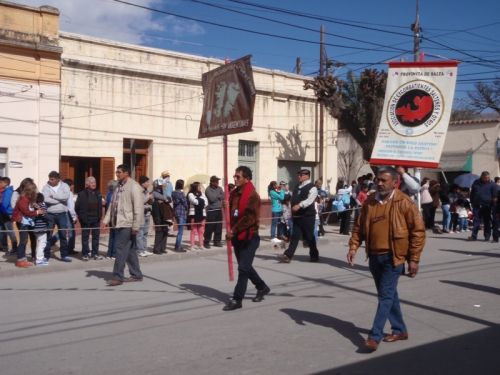


 Meanwhile, the gauchos were gathering for their parade moment – we reckon we must have seen more than a thousand:
Meanwhile, the gauchos were gathering for their parade moment – we reckon we must have seen more than a thousand: 


 After some food, provided by a number of temporary stalls run in aid of local groups etc., and a quick look around the fair, we found the stage for the music festival, which we were surprised to find when we did a little web searching, included some well known national groups in the line-up.
After some food, provided by a number of temporary stalls run in aid of local groups etc., and a quick look around the fair, we found the stage for the music festival, which we were surprised to find when we did a little web searching, included some well known national groups in the line-up. 


The Paso de Sico
So, after an expected but very welcome dose of local culture, we finally hit the road again towards our first high level Andes pass, the fantastic Paso de Sico, a less travelled quiet road, which, to start with, follows the track of El Tren de la Nubes. 
 The pass reaches 4,560m at it’s highest, passing volcanos and flocks of llamas and vicuña, over the Andes and the border into Chile.
The pass reaches 4,560m at it’s highest, passing volcanos and flocks of llamas and vicuña, over the Andes and the border into Chile. 




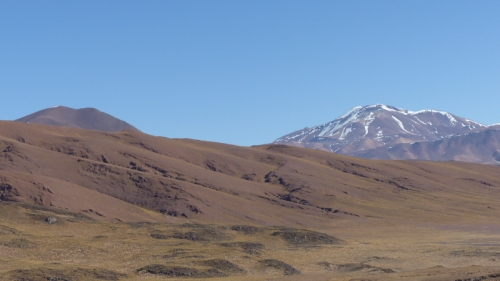



 On the other side of the border, the road took us passed spectacular salt lakes, with lines of volcano peaks along the border with Bolivia, opening up in front of us.
On the other side of the border, the road took us passed spectacular salt lakes, with lines of volcano peaks along the border with Bolivia, opening up in front of us. 




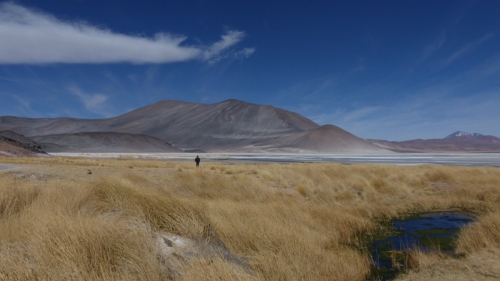


 And finally, the Salar de Atacama, our first sight of the Atacama Desert, lay before us.
And finally, the Salar de Atacama, our first sight of the Atacama Desert, lay before us. 
For fellow gaucho fans, here’s a little gallery of more pictures from the day of the virgin of the gauchos in Salta and the independence day parade in Campo Quijana:










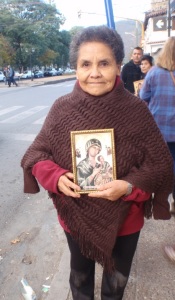












Very Impressive!
Walter
LikeLike
Thanks Walter – it was a fun few weeks!
LikeLike
It looks like for most of the trip you’ve been rather lucky! Particularly with the Inca celebrations at Shincal.
LikeLiked by 1 person
Thanks Juergen – if the loss of the heater is the worst that happens to us, we will indeed have been very lucky!
LikeLike
Rebecca, this looks amazing…. really interesting to read all about it! Emma & Chris X
LikeLiked by 1 person
Thanks Em – glad you’re enjoying it. Lovely to hear from you. R
LikeLike
Great photos, as ever!
Your Shincal experience reminds me of one midsummer’s eve, taking a break in Avebury on the way back to Oxford, and hearing a lone druid playing a pipe. Not so exotic, but a nice interlude, nevertheless.
LikeLike
Thanks Robin, but your Avebury experience was probably not that dissimilar – our stone circles are pretty amazing!
LikeLike
Wow, stunning scenery and top camp and lunch stops! Hope you are both well.
LikeLike
Thanks Ingrid – it was a fab drive! We’re enjoying the delights of Bolivia now… (But not enjoying trying to use WordPress on a phone with ropey internet connection – for a moment there your comment was flagged as spam!)
LikeLike